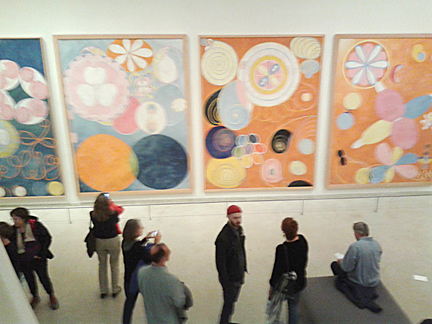Hilma af Klint Retrospective at the Guggenheim
Dear Reader,
A sublime part of visiting New York’s Guggenheim museum
is surrendering to its space. My preference is to go directly
to the top of the spiral and work downward. The trade-off is
that chronological exhibitions are backward, which never bothers
me at all.
In the case of Swedish artist Hilma af Klint’s (1862-1944)
retrospective, the top of the spiral presented her late minimalist
geometrical paintings, final expressions of a life of artmaking.
A picture is worth a thousand words, so I encourage you to put
her name into your search engine and spend time looking.
Klint was allowed to attend art school in Sweden. Early on,
she produced landscapes a la Jean-Baptist-Camille Corot and
beguiling portraits. Her talent was obvious. However, she chose
a different path, and spiritualism guided her into abstraction.
Wending one’s way floor-by-floor down the ramp, her radical
(for the time) abstract work was a revelation. Klint produced
her paintings years BEFORE Miro, Picasso, Klee, Malevich, Mondrian
or Marsden Hartley. This pioneer of abstraction employed floral,
biomorphic and geometric shapes (letters and words, too –
pay attention, Jasper Johns). It is probable that none of these
abstract artists were inspired by her work because they never
saw it.
Because of my downward spiral approach, the climax came in a
lower gallery which held a set of gobsmackingly-incredible works
she called “The Ten Largest.” Indeed. They are ten
by eight feet. She must have had a time in her long skirts working
canvases as big as sails.
I have seen and made a lot of art in my life, but this series
was THE MOST RAVISHING ART I HAVE EVER SEEN. Period.
Hilma af Klint knew what the art world was ready for and that
her art wasn’t it. She held back from exhibiting during
her lifetime. She even went so far as to stipulate that her
work was not to be shown until 20 years after her death. She
hardly needed to worry: a few sporadic exhibits were held in
Europe in the 1980’s. After all, who was she, anyway?

